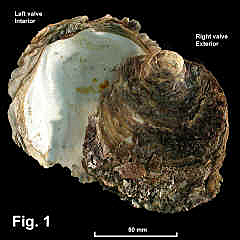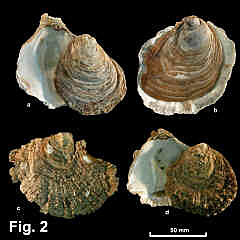|
|
OSTREIDAE |
|
|
|
Ostrea angasi G.B. Sowerby II, 1871 Mud Oyster or Angasi Oyster Description: Shell very solid, heavy. Shape variable but usually roughly circular or oval. Lower (left) valve only moderately cup shaped, conforming to substrate surface as juvenile but free living as adult; upper (right) valve flat or weakly concave or convex. Hinge short. Interior porcellaneous white within margin, muscle scar almost central, margins fluted. Exterior of lower valve radially ribbed; upper and lower valves densely foliaceous. Shell colour purple-brown or grey. Size: Up to 180 mm diameter. Distribution: Endemic to Australia; Port Stephens, central NSW, southwards and around southern Australia, to south-western WA, including Tas. Habitat: Lives on muddy, sandy or rubble substrates in bays and estuaries from the lowest low tide level and below. The deepest taken specimen in the Australian Museum collection is from 110 m depth; Cotton (1961) reported it down to 96 fathoms (175 m) in SA. The larvae settle on solid substrates but the spat detach at about 25 mm in size and settle on the bottom. Although they are referred to as a mud oysters, they require access to an inhalant flow of water and cannot live if completely buried in mud. Adults are sometimes found on reefs of dead oyster rubble which allow a good water flow. Comparison: This species is identified by its large size and subtidal habitat. Juvenile specimens can be distinguished from Saccostrea glomerata by being flatter and by lacking chomata inside the shell margin. Synonymy: Ostrea sinuata Lamarck, 1819 is a synonym based on SA shells. This species is not the similar-looking Ostrea edulis Linnaeus, 1758, which is a European species. However, there has been a report that Ostrea edulis has been introduced into Western Australia (Morton et al, 2003); this needs verification. Remarks: This species was used for food by the Aborigines and large middens of discarded shells were created. It was abundant at the start of European settlement in Australia but was overfished and became less common towards the end of the 19th century. The European settlers used shells for making lime, which was then used for mortar for bricklaying. In the 1870s government contracts called for lime made from live taken shells, as it provided a superior product! At the time of writing (2024), the species is being farmed by aquaculture companies in NSW, South Australia and Tasmania. Fig. 1: Gunnamatta Bay, NSW (C.075488) Fig. 2: a. Trawled off Sydney (DLB3463). b. Babel Island, Bass Strait (DLB4935). c. Simsons Beach, Port Hacking (C.104628). d. Off Fairlight, Sydney Harbour (C.120227).
|
|

